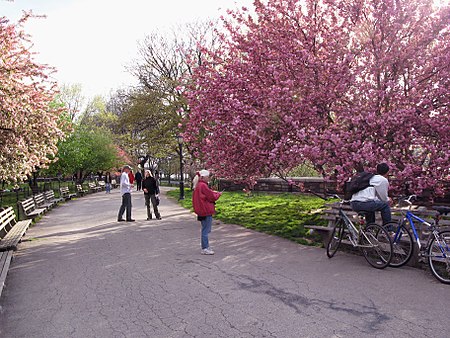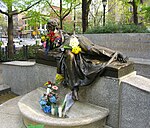Riverside Park (Manhattan)

Riverside Park is a scenic waterfront public park in the Upper West Side, Morningside Heights, and Hamilton Heights neighborhoods of the borough of Manhattan in New York City. The park measures 4-mile (6.4 km) long and 100 to 500 feet (30 to 152 m) wide, running between the Hudson River/Henry Hudson Parkway and the serpentine Riverside Drive. Riverside Park was established by land condemnation in 1872 and was developed concurrently with Riverside Drive. Originally running between 72nd and 125th Streets, it was extended northward in the first decade of the 20th century. When the park was first laid out, the right-of-way of the New York Central Railroad's West Side Line blocked access to the river. In the 1930s, under parks commissioner Robert Moses's West Side improvement project, the railroad track was covered with an esplanade and several recreational facilities. Few modifications were made to the park until the 1980s, when it was renovated and extended southward as part of the Riverside South development. Riverside Park is part of the Manhattan Waterfront Greenway, a pedestrian and bicycle route around Manhattan's waterfront. The New York City Department of Parks and Recreation operates and maintains the park, though its operating activities are supported by the Riverside Park Conservancy. It is listed on the National Register of Historic Places and designated a New York City scenic landmark.
Excerpt from the Wikipedia article Riverside Park (Manhattan) (License: CC BY-SA 3.0, Authors, Images).Riverside Park (Manhattan)
Henry Hudson Parkway, New York Manhattan
Geographical coordinates (GPS) Address Nearby Places Show on map
Geographical coordinates (GPS)
| Latitude | Longitude |
|---|---|
| N 40.804166666667 ° | E -73.97 ° |
Address
Neville Colman Field
Henry Hudson Parkway
10115 New York, Manhattan
New York, United States
Open on Google Maps








